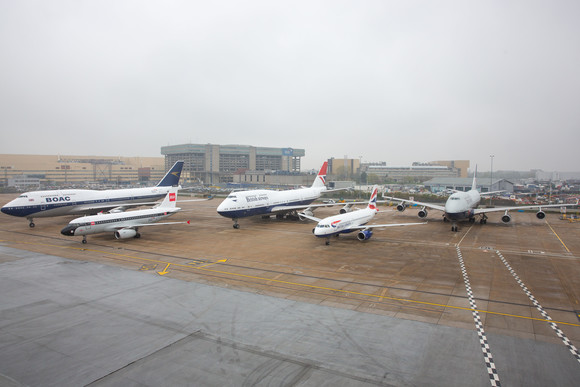LONDON, UK, 2019-Apr-11 — /Travel PR News/ — British Airways has, for the first time today (April 9, 2019), brought together its four heritage liveried aircraft which were repainted to mark the airline’s centenary this year, alongside an A319 in the current Chatham Dockyard livery, to capture a rare image of some of the airline’s most iconic designs together.
The photos captured today also mark the fact that 50,000 customers have already flown around the globe on the four heritage liveries since they re-joined the fleet, with the Boeing 747s having travelled to destinations such as New York, Cape Town, Dubai and Lagos, while the BEA liveried Airbus A319 has flown far and wide across the airlines’ UK and European network to cities including Manchester, Newcastle, Edinburgh, Milan, Zurich and Amsterdam.
Alex Cruz, British Airways’ Chairman and CEO, said: “The excitement and pride that we’ve witnessed from customers and colleagues as these heritage liveries, which we painted to mark our centenary, have flown around the globe has been unparalleled.
“Social media has been fired up with images from travellers all over the world when they’ve spotted the aircraft and as some 50,000 people have now flown on them since they arrived back in the fleet we wanted to capture a special photo to share with them.”
To capture the photo, the four heritage aircraft, which were in scheduled downtime and parked at the airline’s engineering base, were lined up alongside an aircraft with the current Chatham Dockyard design.
The painstaking process of arranging them for the photo took over two (careful) hours.
The retro designs are part of a special series to mark British Airways’ centenary, as the airline celebrates its past while looking to the future and can be followed using tracking website Flightradar24, which features special images of the aircraft.
In this, its centenary year, British Airways is hosting a range of activities and events. As well as looking back, the airline is also hosting BA 2119 – a programme, which will lead the debate on the future of flying and explore the future of sustainable aviation fuels, the aviation careers of the future and the customer experience of the future.
The airline will be working with expert partners to identify BA’s 100 Great Britons; the people up and down the country who are currently shaping modern Britain, and of course, the year would not be complete without some special flying and moments for customers.
The centenary activity is taking place alongside the airline’s current five-year £6.5bn investment for customers. This includes the installation of the best quality WiFi and power in every seat, fitting 128 long-haul aircraft with new interiors and taking delivery of 72 new aircraft. The airline has also revealed a brand-new business class seat with direct aisle access, the Club Suite, which will debut on the Airbus A350 later this year.
Notes to editors:
- The Boeing 747 in BOAC livery (G-BYGC) arrived in to LHR on February 18, 2019
- The Airbus A319 in BEA livery (G-EUPJ) arrived in to LHR on March 3, 2019
- The Boeing 747 in Landor livery (G-BNLY) arrived in to LHR on March 9, 2019
- The Boeing 747 in Negus livery (G-CIVB) arrived in to LHR on March 21, 2019
A potted history of BA:
- On August 25, 1919, British Airways’ forerunner company, Aircraft Transport and Travel Limited (AT&T), launched the world’s first daily international scheduled air service between London and Paris.
- In 1924, Britain’s four main fledgling airlines, which had by then evolved into Instone, Handley Page, Daimler Airways (a successor to AT&T), and British Air Marine Navigation Company Limited, merged to form Imperial Airways Limited.
- By 1925, Imperial Airways was providing services to Paris, Brussels, Basle, Cologne and Zurich. Meanwhile, a number of smaller UK air transport companies had started flights and in 1935, they merged to form the original privately-owned British Airways Limited, which became Imperial Airways’ principal UK competitor on European routes.
- Following a Government review, Imperial Airways and British Airways were nationalised in 1939 to form British Overseas Airways Corporation (BOAC). Continental European and domestic flights were flown by a new airline, British European Airways (BEA) from 1946. BOAC introduced services to New York in 1946, Japan in 1948, Chicago in 1954 and the west coast of the United States in 1957. BEA developed a domestic network to various points in the United Kingdom, including Belfast, Edinburgh, Glasgow and Manchester.
- From 1946 until 1960, BOAC and BEA were the principal British operators of scheduled international passenger and cargo services – and they preserved Britain’s pioneering role in the industry. The 1950s saw the world enter the passenger jet era – led by BOAC, with the Comet flying to Johannesburg in 1952, halving the previous flight time.
- Additional airlines began to pass into BEA’s ownership and in 1967, the Government recommended a holding board be responsible for BOAC and BEA, with the establishment of a second force airline, resulting in British Caledonian being born in 1970.
- Two years later, the businesses of BOAC and BEA were combined under the newly formed British Airways Board, with the separate airlines coming together as British Airways in 1974.
- In July 1979, the Government announced its intention to sell shares in British Airways and in February 1987 British Airways was privatised.
- In January 2011 the International Consolidated Airlines Group (IAG) was formed when British Airways and Iberia merged. IAG has since also become the parent company of Aer Lingus, and Vueling and in 2017, IAG launched LEVEL a new low-cost airline brand that operates from Barcelona, Paris and Vienna.
Contact Details:
For more information please contact press.office@ba.com.
Source: British Airways
###

